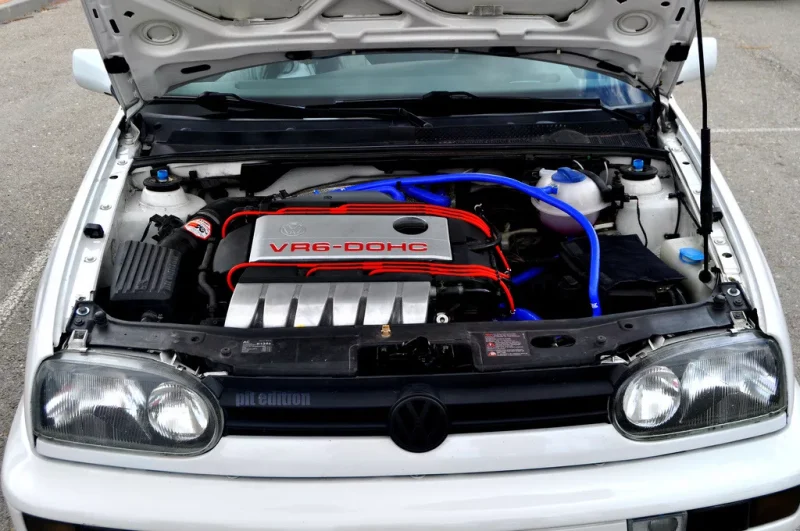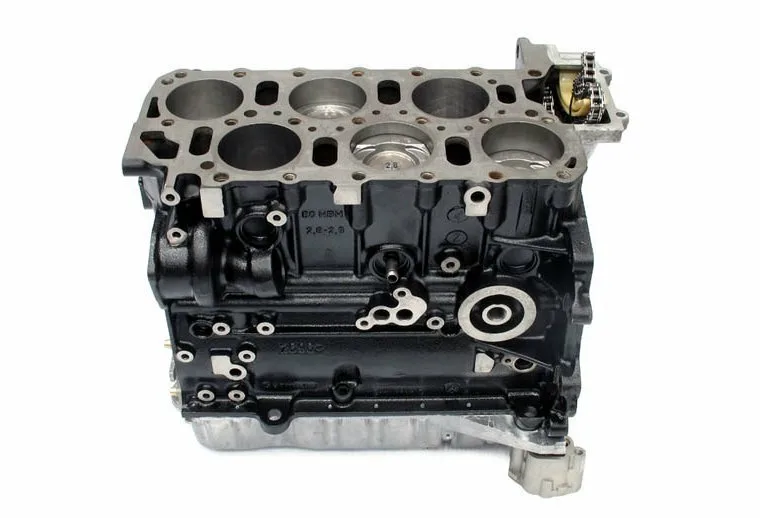A distinctive feature of VR6 motors from VAG is that they are not in-line, but they are not V-shaped either. They are row-shifted. They are located in a single cast-iron block, but with an offset relative to each other only 15 degrees. It’s a sort of very narrow V configuration. And for all of them – a single cylinder head.
Originally, such motors appeared back in 1991. Most of them were with a working volume of 2.8 liters, but there were variations of 2.9 liters.
Such motors were produced until 1999, with a configuration of 12 valves (that is, 2 pieces on each cylinder). Later they were replaced by 24-valve, more advanced variations. But those same VG6 were put on almost the entire range of models from VW. Starting with the Golf 3 and ending with the Transporter. And in their time, they were considered very promising and advanced. Even Diamler company actively purchased them and used them in its beads. They were also put in Ford Galaxy, which is actually a copy of Sharan.
How reliable are VR6s
One of the main advantages of VR6 is an uncomplicated design. Practice shows that in this case, the probability of serious breakdowns is significantly reduced. And this motor in practice has shown itself to be very reliable. It does not cause any special troubles to the owner, and capital maintenance is required only in those situations when it is not engaged for years at all, but at the same time regularly subjected to critical loads.
In terms of repair cost, VR6 is cheaper than newer VAG. And the most complaints in cars with this engine are found on the wiring and other plastic elements, which over time are banally worn out and cracked. This applies to the Ford Galaxy. Well, and the rest of the “unpredictability” arise only against the background of wear and tear of sensors.
Early versions of VR6, where trambler ignition is used, are considered a little more troublesome because of the mechanical throttle (flap). Its stroke is regulated by an electric actuator. Again – the contacts are often damaged by corrosion. Even a slight change in electrical resistance will not be enough for inadequate behavior of the actuator. Most often this is accompanied by a significant “overflow” of fuel in the mixture. Nothing critical, repaired elementary, but an inexperienced car owner unfamiliar with the basic problems of VR6, it can cause bewilderment.

And sometimes there are problems with the secondary air pump. It is removed by most, but if this is not done, air is “sucked” into the preceding valve at the catalytic converter. But the lambda probe reacts to all this. That is, the sensor again inadequately assesses the composition of the fuel mixture. And because of allegedly excess air – increases the fuel supply, causing overflow.
VR6 in principle cannot be called an economical engine. And without adequate and timely maintenance, the consumption increases significantly. This is precisely what indicates the occurrence of the above problems.
Tensioner roller
It is massive here, which was traditional for VAG of those years. And it is sold with the damper as a single set. In total, it will cost the car owner as much as 160 dollars. But analogs at a more affordable price – a lot, on average – for 30 dollars you can pick up an adequate replacement, in quality and reliability is not inferior to the original.
Experienced mechanics generally recommend that the tensioner be replaced at each change of the drive belt. According to the technical regulations provided by the manufacturer, it should be done approximately every 120 thousand kilometers of mileage.
About the ignition module
The very first “original” VR6 used a trampler, which later caused a lot of trouble. Later, the design was completely transferred to electronic ignition. The system is based on a common coil, which is considered traditional for all engines of that generation. But for a new one it will be necessary to give as much as 600 – 650 dollars. There are more than enough alternatives, at a price 6 – 7 times cheaper.
And with the original coil there are problems: with time it is covered with cracks. Predominantly where the high-voltage leads are located. There is nothing terrible in this, but in a rainstorm or after getting moisture under the hood there is a probability of “punching” the spark. This does not lead to serious consequences, but the spark plug ignition cycle is skipped. And is accompanied, respectively, by unstable operation of the engine. You can correct the shortcoming yourself at home: covering the cracked body with a layer of epoxy glue. Simple, cheap, but reliable.
A little bit about nozzles
Structurally, nozzles are as simple as possible. That is why they break down very rarely. Situations when they are actively used for more than 15 years are not rare. Naturally, cleaning the fuel system at least with additives in the tank will not be superfluous, but more radical methods of maintenance can really be abandoned.

And what causes problems is the submersible pump and the pressure regulator (which is on the ramp). If the first generates less than 3 bar (and for some 4 bar, you need to look at the markings on the sensor), then again the car owner will encounter improper mixing of the fuel mixture. This can be controlled through the usual throttle. Naturally, you can adjust everything yourself. At the same ignition timing the optimum values will be from 4 to 7 bar.
Heat exchanger
The heat exchanger is located near the oil filter, which is already a classic for all VAG-motors of the 90s generation. There are no significant problems, but the factory gaskets are not the most successful and durable. It is with them mostly there is a problem, but analogs for replacement – a huge choice.
GTM drive
Here, too, the classic for its years scheme with the chain location on the flywheel side is used. Its operational life is impressive – up to 200 thousand kilometers. But over time, it still stretches and wears out. At first it is accompanied by a kind of metallic “rattle”. And to further aggravation should not be allowed, because there are known cases with tearing out of teeth, and with jamming.
And to assess the condition of the chain, it is enough to inspect the level of protrusion of the rod. When the stretch is too great, it often slips along. Accordingly, oil gets past, starts to leak. And when starting the engine, especially after a long parking, again there will be a rumble. In fact, this is a problem with the oil supply.
Cylinder Head Gasket
Naturally, they can burn through, if you do not change them for more than 20 years. Because of this, air and oil get into the antifreeze, and problems with maintaining a stable temperature begin. Often air jams are formed, because of which the thermostat does not work correctly or opens immediately after starting the engine, which increases the heating time. In general, this should also be paid attention to.
Cylinder block
It can be considered the most reliable element in VG6. Because in any car service center faced with such motors, which have already driven about 500 thousand kilometers. And no significant problems with them during this period did not arise.
Conclusion
It can be considered that VG6 is a very reliable option, cars with which were previously purchased by those who were willing to put up with uneconomical fuel consumption. Structurally quite simple, although with some technical nuances. For self-service – not a bad option. And special attention should be paid only to wiring, plastic elements under the hood, chain tension adjustment. But if all this is updated in time, you can count on the absence of significant problems with the motor in the next 10 years.
